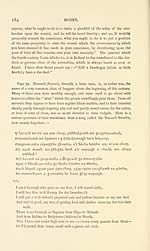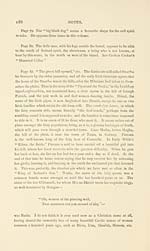Blair Collection > Beside the fire
(247)
Download files
Complete book:
Individual page:
Thumbnail gallery: Grid view | List view

NOTES. 185
The memory of these formidable guests is nearly vanished, and the boccuch in
our story is only a feeble old beggarman. I fancy this tale of evicting the
alt-pluachra family from their human abode is fathered upon a good many
people as -well as upon the father of the present MacDermot. [Is the peasant
belief in the Alp-Luachra the originating idea of the well-known Irish
Rabelaisian 14th century tale " The Vision of McConglinny ? " — A.N.]
Tjie Weasel.
Page 73. The weasel, like the cat, is an animal that has many legends and
superstitions attaching to it. I remember hearing from an old shanachie, now
unfortunately dead, a long and extraordinary story about the place called
Chapelizod, a few miles from Dublin, which he said was Séipeub-eAfój, the
"weasel's chapel,'' in Irish, but which is usually supposed to have received
its name from the Princess Iseult of Arthurian romance. The story was the
account of how the place came by this name. How he, who was a Con-
nachtman, and never left his native county except to reap the harvest in
England, came by this story I do not know ; but I imagine it must have
been told him by some one in the neighbourhood, in whose house he
spent the night, whilst walking across the island on his way to Dublin
or Drogheda harbour. The weasel is a comical little animal, and one
might very well think it was animated with a spirit. I have been assured
by an old man, and one whom I have always found fairly veracious, that
when watching for ducks beside a river one evening a kite swooped down
and seized a weasel, with which it rose up again into the air. His
brother fired, and the kite came down, the weasel still in its claws, and un-
hurt. The little animal then came up, and stood in front of the two men
where they sat, and nodded and bowed his head to them about twenty times
oyer; "it was," said the old man, "thanking us he was." The weasel is a
desperate fighter, and always makes for the throat. What, however, in Ire-
land is called a weazel, is really a stoat, just as what is called a crow in Ireland
's really a rook, and what is called a crane is really a heron.
Cáuher-na-mart, to which Paudyeen (diminutive of Paddy) was bound, means
the " city of the beeves," but is now called in English Westport, one of the
largest towns in Mayo. It was apropos of its long and desolate streets of ruined
stores, with nothing in them, that some one remarked he saw Ireland's charac-
teristics therein a nutshell — "an itch after greatness and nothingness;" a
remark which was applicable enough to the squireocracy and bourgeoisie of
the last century.
The memory of these formidable guests is nearly vanished, and the boccuch in
our story is only a feeble old beggarman. I fancy this tale of evicting the
alt-pluachra family from their human abode is fathered upon a good many
people as -well as upon the father of the present MacDermot. [Is the peasant
belief in the Alp-Luachra the originating idea of the well-known Irish
Rabelaisian 14th century tale " The Vision of McConglinny ? " — A.N.]
Tjie Weasel.
Page 73. The weasel, like the cat, is an animal that has many legends and
superstitions attaching to it. I remember hearing from an old shanachie, now
unfortunately dead, a long and extraordinary story about the place called
Chapelizod, a few miles from Dublin, which he said was Séipeub-eAfój, the
"weasel's chapel,'' in Irish, but which is usually supposed to have received
its name from the Princess Iseult of Arthurian romance. The story was the
account of how the place came by this name. How he, who was a Con-
nachtman, and never left his native county except to reap the harvest in
England, came by this story I do not know ; but I imagine it must have
been told him by some one in the neighbourhood, in whose house he
spent the night, whilst walking across the island on his way to Dublin
or Drogheda harbour. The weasel is a comical little animal, and one
might very well think it was animated with a spirit. I have been assured
by an old man, and one whom I have always found fairly veracious, that
when watching for ducks beside a river one evening a kite swooped down
and seized a weasel, with which it rose up again into the air. His
brother fired, and the kite came down, the weasel still in its claws, and un-
hurt. The little animal then came up, and stood in front of the two men
where they sat, and nodded and bowed his head to them about twenty times
oyer; "it was," said the old man, "thanking us he was." The weasel is a
desperate fighter, and always makes for the throat. What, however, in Ire-
land is called a weazel, is really a stoat, just as what is called a crow in Ireland
's really a rook, and what is called a crane is really a heron.
Cáuher-na-mart, to which Paudyeen (diminutive of Paddy) was bound, means
the " city of the beeves," but is now called in English Westport, one of the
largest towns in Mayo. It was apropos of its long and desolate streets of ruined
stores, with nothing in them, that some one remarked he saw Ireland's charac-
teristics therein a nutshell — "an itch after greatness and nothingness;" a
remark which was applicable enough to the squireocracy and bourgeoisie of
the last century.
Set display mode to: Large image | Transcription
Images and transcriptions on this page, including medium image downloads, may be used under the Creative Commons Attribution 4.0 International Licence unless otherwise stated. ![]()
| Early Gaelic Book Collections > Blair Collection > Beside the fire > (247) |
|---|
| Permanent URL | https://digital.nls.uk/76246412 |
|---|
| Description | A collection of Irish Gaelic folk stories. |
|---|---|
| Shelfmark | Blair.222 |
| Additional NLS resources: | |
| Attribution and copyright: |
|
| Description | A selection of books from a collection of more than 500 titles, mostly on religious and literary topics. Also includes some material dealing with other Celtic languages and societies. Collection created towards the end of the 19th century by Lady Evelyn Stewart Murray. |
|---|
| Description | Selected items from five 'Special and Named Printed Collections'. Includes books in Gaelic and other Celtic languages, works about the Gaels, their languages, literature, culture and history. |
|---|

